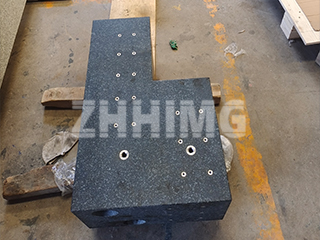For professionals in precision manufacturing, machining, or quality inspection, granite and marble V-frames are indispensable positioning tools. However, a common question arises: why can’t a single V-frame work effectively, and why must they be used in pairs? To answer this, we first need to understand the unique structural and positioning characteristics of V-frames—especially how their dual positioning surfaces differ from standard single-surface positioning components.
1. The Dual-Surface Design: Beyond “Single-Component” Positioning
At first glance, a V-frame appears to be an independent positioning element. But its core advantage lies in its two integrated positioning planes, which form a V-shaped groove. Unlike single-plane, spherical, or cylindrical positioning tools (where the reference is a single point, line, or surface—such as a flat tabletop or a shaft’s centerline), V-frames rely on the combination of two planes for precision.
This dual-surface design creates two critical positioning references:
- Vertical Reference: The intersection line of the two V-groove planes (ensures the workpiece stays aligned vertically, preventing tilting).
- Horizontal Reference: The symmetry center plane formed by the two planes (guarantees the workpiece is centered horizontally, avoiding offset in left-right directions).
In short, a single V-frame can only provide partial positioning support—it cannot independently stabilize both vertical and horizontal references. This is where paired use becomes non-negotiable.
2. Why Pairing Is Non-Negotiable: Avoid Errors, Ensure Consistency
Think of it like securing a long pipe: one V-frame at one end might hold it up, but the other end would sag or shift, leading to measurement or machining errors. Pairing V-frames solves this by:
a. Full Workpiece Stabilization
Two V-frames (placed at appropriate intervals along the workpiece) work together to lock in both vertical and horizontal references. For example, when inspecting a cylindrical shaft’s straightness or machining a precision rod, paired V-frames ensure the shaft stays perfectly aligned from end to end—no tilting, no lateral movement.
b. Eliminating Single-Frame Limitations
A single V-frame cannot compensate for “unbalanced” forces or workpiece weight. Even small deviations (e.g., a slightly uneven workpiece surface) would cause the part to shift if only one V-frame is used. Paired V-frames distribute pressure evenly, minimizing vibration and ensuring consistent positioning accuracy.
c. Matching Industry-Standard Positioning Logic
This is not just a “best practice”—it aligns with universal precision positioning principles. For instance, when a workpiece uses “one surface + two holes” positioning (a common method in manufacturing), two pins (not one) are used to define the horizontal reference (via their center line). Similarly, V-frames need a “partner” to fully activate their dual-reference advantage.
3. For Your Operations: What Paired V-Frames Mean for Quality & Efficiency
If you’re working with precision components (e.g., shafts, rollers, or cylindrical parts), using granite/marble V-frames in pairs directly impacts:
- Higher Accuracy: Reduces positioning errors to ±0.001mm (critical for aerospace, automotive, or medical part manufacturing).
- Longer Tool Life: Granite/marble’s wear resistance (and paired stability) reduces tool wear from misalignment.
- Faster Setup: No need for repeated adjustments—paired V-frames simplify alignment, cutting down on setup time.
Ready to Upgrade Your Precision? Talk to Our Experts
At ZHHIMG, we specialize in high-precision granite and marble V-frames (paired sets available) tailored to your machining, inspection, or calibration needs. Our products are crafted from high-density marble/granite (low thermal expansion, anti-vibration) to ensure long-term accuracy.
Post time: Aug-27-2025

